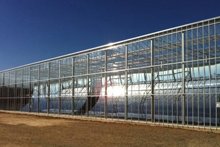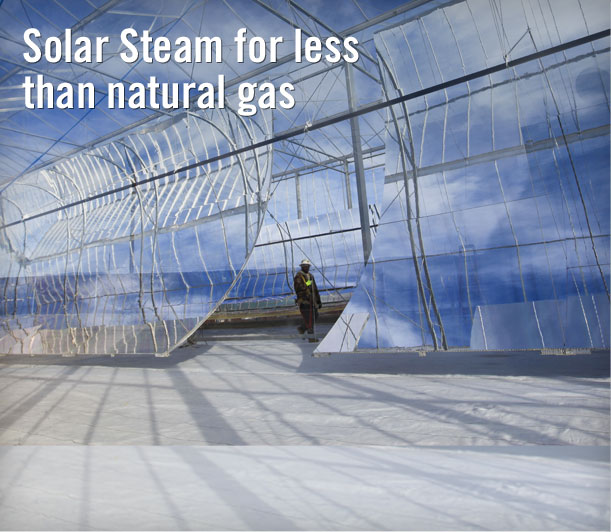|
Two Examples of the Many Possible Benefits of Solar Steam
There are many uses for steam – and solar steam, i.e., steam produced from solar energy, can be a cost competitive way to supply this steam as the following two examples demonstrate.
Today, the application of hot steam is considered the best and most effective way to disinfect sick soil, potting soil and compost. "Steam effectively kills pathogens by heating the soil to levels that kill pests such as weeds, bacteria, fungi and viruses. Biologically, the method is considered a partial disinfection. Important heat-resistant, spore-forming bacteria survive and revitalize the soil after cooling down. Soil fatigue can be cured through the release of nutritive substances blocked within the soil. Steaming leads to a better starting position, quicker growth and strengthened resistance against plant disease and pests. Old civilizations such as India and Egypt used solar steam generated through the targeted usage of incident solar radiation on watered top soil to sanitize and revive their arable land. Modern soil steam sterilization was first discovered in 1888 (by Frank in Germany) and was first commercially used in the United States (by Rudd) in 1893 (Baker 1962). Since then, a wide variety of steam machines have been built to disinfest both commercial greenhouse and nursery field soils. Solar produced steam could also be used for such purposes and when combined with solar panels would provide a greenhouse, for example with electricity, heat and steam for improving the quality of the soil – which is important for high cash crops like flowers, spices, exotic plants, etc.
Extracting heavy oil from the ground carries a large carbon footprint, because the oil must be coaxed from the earth with steam. In California's Kern County, where steam-hungry oil fields account for 9 percent of the state's natural-gas consumption, GlassPoint Solar is testing an alternative: a one-acre greenhouse full of solar heat collectors. The Fremont, California, firm hopes this method will deliver steam in a way that's cleaner and cheaper than burning natural gas. 
Steam clean: GlassPoint Solar erected this greenhouse-protected solar thermal system to concentrate heat and generate steam for an oil field in McKittrick, California. Credit: GlassPoint Solar. GlassPoint's technology is a cut-rate version of commercial solar thermal power plants that use mirrors to focus sunlight on pipes and then convert the captured heat to steam to drive power-generating turbines. GlassPoint's system is cheaper because it doesn't need the turbines, and because it has redesigned its mirrors and pipes to pump out steam that's 250 °C to 300 °C (whereas the steam required to drive turbines must be 350 °C to 400 °C). Also, rather than building steel structures to support weather-hardened precision mirrors, GlassPoint uses comparatively flimsy foil mirrors in greenhouses. Its heat-absorbing tubes, meanwhile, are coated steel, rather than the power plants' high-efficiency glass vacuum tubes. The result, predicts John O'Donnell, GlassPoint's vice president of business development, should be steam at a cost of $3 to $3.50 per million BTUs (including federal tax incentives for solar equipment). He compares that to an estimated $11 to $12 per million BTUs for conventional solar thermal collectors, and roughly $4 for natural gas. 
The spread over natural gas will widen under California's cap and trade system, set to take effect next year, which will add at least 50 cents per million BTUs to the cost of gas-fired steam. O'Donnell says the pilot plant unveiled at a site operated by Berry Petroleum, California's biggest independent oil producer, is intended to provide a rapid test of the system's performance and operating costs. Its 40-meter-long string of mirrors and collectors will provide about one million BTUs of steam per hour, which he acknowledges is barely 1 percent of the site's gas consumption. Assembling and starting up the plant in just six weeks has given GlassPoint a jump over solar thermal power generators eyeing the oil field market. BrightSource Energy expects to complete a solar thermal steam plant this year at an oil field in Coalinga, California, operated by Chevron—a BrightSource investor. Spain's Abengoa Solar, which has already built plants supplying solar steam to a California potato chip factory, a federal prison in Colorado, and a groundwater treatment operation in Arizona, says oil fields are a potential market for its industrial steam systems. Stanford University petroleum engineer Tony Kovscek, an expert in heavy oil recovery and an unpaid advisor to GlassPoint, says he is excited by how easy it is to integrate GlassPoint's system with oil fields burning natural gas. "There's a pretty significant carbon footprint associated with these more viscous oils, and GlassPoint has created the potential to reduce that carbon footprint fairly significantly," says Kovscek. How significantly depends on how quickly oil field operators are willing to adapt and follow the sun's cycle. Kovscek says that under current oil field procedures, which call for heating 24 hours a day, solar steam could displace the one-third of natural gas burned during the day. But he says preliminary research suggests that a large solar plant could inject extra heat during the day and trim overnight heat demand, thus displacing another third of a field's gas consumption. Convincing oil field operators to experiment will take some time, says Kovscek: "The guys who operate these projects are some of the most conservative people you can imagine, and they don't like to change things."
To find more valuable information or advice about the material covered in this post or about any other related or specific subject - use our built-in / Google Powered site searching tool below. Just type in a few key words or phrases to search this website, our solar news and health blogs for related articles. More than 600 articles have been published to date.  Custom Search Back from this page about solar steam to our home page
|


